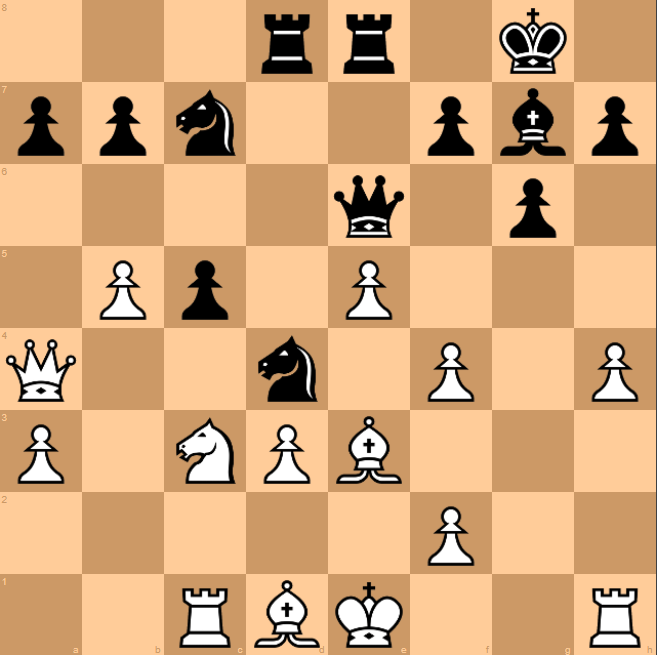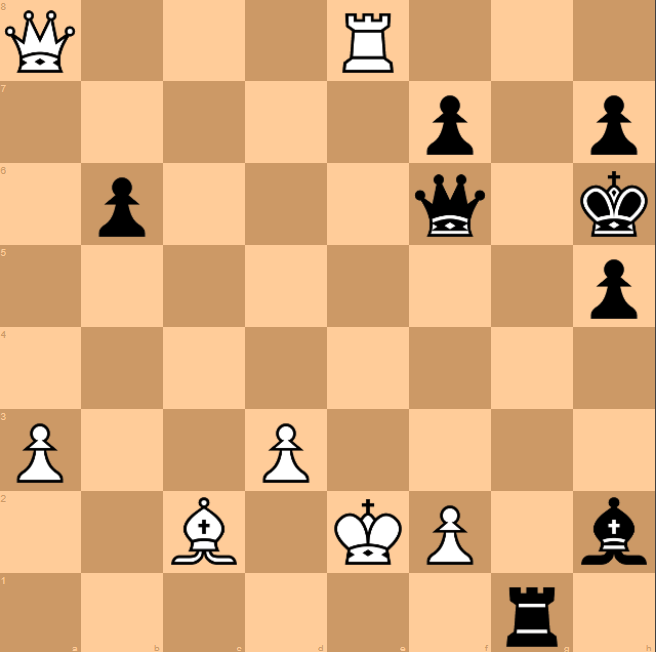New skids on the block

Piers Morgan Uncensored is joined by 20-year-old Chess Grandmaster Hans Niemann
The World Junior (U20) Championship is currently being held at the Hotel del Prado in Mexico City. This prestigious event has prompted FIDÉ, the World Chess Federation, to produce a rigorous and demanding format.
Eleven gruelling rounds with a time control of 90 minutes for the first 40 moves, plus 30 minutes until the end of the game, with 30-second increments from the start, are intended to provide a stamina-sapping test for the 74 competitors. They include our very own British tip-for-the-top, the 14-year-old 2407-rated Shreyas Royal.
However, in a clear warning that a new generation is emerging to dominate future decades, the top 7 highest-rated juniors in the world have elected not to participate. The missing include Alireza Firouzja, Rameshbabu Praggnanandhaa and Vincent Keymer.
This should have left the way clear for everybody’s favourite anti-hero, Hans Moke Niemann, the tournament’s top seed, to consolidate his self-promoted status as champion-in-waiting. Some commentators have even spoken of their expectation that he should destroy all before him in an inexorable journey towards an interim world title.
Sadly for Niemann, other players had not read the script. In the third round, Niemann encountered such an animal, the 13-year-old American International Master, Andy Woodward. In a bruising defeat, one had to wonder whether Niemann had fully researched his opponents. The warning posed to his aspirations were writ large in a brilliant game won by Woodward last year.
Andy Woodward vs. Konstantin Kavutskiy
3rd Hollywood Chess Norm Classic (2022), Los Angeles, CA USA, rd 8, Aug-06
1.d4 Nf6 2. c4 g6 3. g3 Bg7 4. Bg2 O-O 5. Nc3 d6 6. Nf3 c5 7. O-O Nc6 8. d5 Na5 9. Nd2 e6 10. Qc2 Re8
White’s next move prepares to advance his b-pawn two squares, in my opinion never a good idea in such situations. It leaves too many weak points in the c file which Black can dominate.
11.Rb1 exd5 12. cxd5 Rb8 13. b4 cxb4 14. Rxb4 Bf5 15. e4 Bd7 16. a4?!
White needs to be more assertive in challenging the slight advantage Black has developed. Both a) 16. Nb5 Bxb5 17. Rxb5; and b) 16. Bb2 b5 17. Rb1; limit Black more effectively.

16… Rc8?
Black could develop more forcefully with: 16… Qc8! 17. Ba3 (17. Rb2 a6 18. Ra2 Ng4 19. Bb2 b5 20. axb5 axb5 21. Rxb5 Qc3 21. e5 Rxe5 22. Ne4 Rxe4 23. Bxe4 Nb3) 17… Ng4 18. Rc1 Nxf2 19. Kxf2 Qc5+ 20. Kf1 Rbc8 21. Ndb1 Nc4 22. Rxc4 Qxc4+ 23. Qe2 Qc7, when White is material down and Black has by far the more compact position.
17.Bb2 Ng4 18. Nb3?
This is another error. It was important that White attend to the doubly pinned knight on c3, for example: 18. Qd3 Ne5 (18… Qc7 19. Nb5 Qc5 20. Qa3 Ne5 21. Nb3 Nxb3 22. Rxb3) 19. Qe2 Bg4 20. f3 Bd7 21. Kh1 h5 22. Nb5 bxb5 23. axb5 Rc2 24. Bxe5 Bxe5 25. Qd3 is more resilient.
18… Nc4?
A natural move, but hardly the most telling. After 18… Rc4 (18… Ne5 is also good) 19. Rxc4 Nxc4 20. h3 Nge3 21. fxe3 Nxe3 22. Qf2 Nxf1 23. Bxf1 Qc7, White’s position is full of holes.
19.Ba1 b6 20. Nd2 Na5 21. h3 Ne5 22. Qb1 Nf3+ 23. Nxf3 Bxc3 24. Bxc3 Rxc3 25. Qb2 Qc7 26. h4 Qc5 27. h5 f6 28. Nd4 Kf7?!
Better was 28… Kg7, as will become more apparent in the following sequence of moves.

29.Rb1 Rc8?
This ostensibly natural continuation is, in fact, a blunder. Both, a) 29… Re5 30. h6 g5 31. Ne6 Bxe6 32. Rb5 Qc4 33. dxe6+ Rxe6; and b) 29… g5 30. Qd2 h6 31. Ne6 Bxe6 32. Rb5 Rc2 33. Rxc5 Rxd2 34. Rc7+ Re7 35. dxe6+ Kxe6 36. Bh3+ Kf7 37. Rxe7+ Kxe7, are preferable moves.
30.Qd2! Rc1+ 31. Kh2 Rxb1?
Black continues to prosecute his plan without any notion that his world is about to combust. This was Black’s last chance to prevent infiltration via h6, either by 30… Kg7 or …e5.
32.Qh6!!

And with the offer of a double rook sacrifice, it becomes apparent that Black is losing. Black’s king has no protection from the marauding queen, accompanied by her menacing pawns. This is a concept of pure genius.
32… Rxb4 33. Qxh7+ Ke8
But not 33… Kf8?? 34. hxg6 Ke8 35. Qf7+ Kd8 36. Ne6+ Bxe6 37. dxe6 Qc6 38. g7 Qe8 39. g8=Q Qxg8 40. Qd7 checkmate.
34.Qg8+ Ke7 35. Qg7+ Kd8 36. Ne6+ Bxe6 37. dxe6 Qc6
Not 37… Qxh5+ 38. Bh3 Qb5 39. axb5 Ke8 40. Qf7+ Kd8 41. Qd7 checkmate.

38.e5!?
In the midst of battle, White loosens his grip on his weapon. A terminal attack would follow, 38. e7+!! Kd7 39. Bh3+ f5 40. exf5 Re8 41. f6+ Kc7 42. f7 Re4 43. Bg2 R8xe7 44. hxg6 d5 45. Bxe4 dxe4 46. f8=Q Rxg7 47. Qxg7+, when Black can’t credibly stop the g6 pawn queening.
38… Qe8
The teenage prodigy is still winning but it’s technical now, not pyrotechnical.
39.exf6 Rc5 40. f7 Rxh5+ 41. Bh3 Rxh3+ 42. Kxh3 Qxe6+ 43. Kh2 Qxf7 44. Qxf7 Nc6 45. Qxg6 Kd7 46. Qf7+ Ne7 47. f4 Rxa4 48. f5 Re4 49. f6 a5 50. fxe7 Rxe7 51. Qd5 Kc7 52. g4 Re5 53. Qg8 a4 54. Qc4+ 1-0
And so it was that Niemann, ensconced on board one, joint leader entering the third round, faced playing with the white pieces, an obstacle who had probably not previously reckoned highly among those hurdles Niemann had identified as significant impediments to his lofty ambitions…
FIDE World Junior U20 ch (2023), Mexico City MEX, rd 3, Sep-22
1.Nf3 Nf6 2. c4 g6 3. Nc3 Bg7 4. e4 e5 5. Nxe5
I pioneered this line in my win against Tony Miles from Hastings 1973/4. In those early days it had not been appreciated that Black could handle this variation as the gambit of a pawn.
5… O-O 6. Nf3 Re8 7. d3 d5 8. cxd5 Nxd5 9. Bd2 Bg4 10. Be2 Nb4 11. Be3 Bxf3 12. gxf3 N8c6 13. h4 Nd4 14. Rc1

14… Qd6
In fact, this is all following modern openings theory, with 14… Qd7 being the previously approved recommendation, designed to imbue Black’s position with sufficient energy and control to justify his investment of a pawn.
15.a3 Na6 16. f4 Rad8 17. b4
Here, 17. h5 comes strongly into consideration.
17… c5 18. e5 Qe7 19. b5?!
It seems a strange decision to encourage Black to redeploy his poorly situated knight, with tempo. A more challenging continuation was, 19. Ne4 (19. Qa4 cxb4 20. Ne4 Nf5 transposes) 19… cxb4 20. Qa4 Nf5 21. h5 bxa3 22. Rb1 Nc7 23. Rxb7, with great activity.
19… Nc7 20. Qa4 Qe6?!
Relinquishing the initiative. Better was 20… h5 or …Nce6.
21.Bd1?

An outright blunder. White is doing fine after either, a) 21. Qxa7 b6 22. Bxd4 cxd4 23. Qxc7 Rc8 24. Qd6 Qxd6 25. exd6 Rxc3 26. d7 Rd8 27. Ra1 Bf8 29. a4; or, b) 21. Qc4 Qf5 22. h5 g5 23. fxg5 Nce6 24. g6 hxg6 25. hxg6 Qxg6 26. Ne4; with chances for both players.
21… Qf5 22. Qc4 Bh6 23. Ne4 Bxf4 24. Nf6+?
White is feeling the pressure. Relatively best here, was, Bg4 Qxe5 25. Qxc5 h5 26. Qxc7 Qxc7 27. Nf6+ Kg7 28. Nxe8+ Rxe8 29. Rxc7 Bxc7 30. O-O, when Black is markedly better.
24… Kg7 25. Nxe8+ Rxe8 26. Qxc5 Ncxb5?!
A gift! Best was 26… Nce6! 27. Qb4 Qxe5 28. Kd2 Qd5 29. Rg1 Qf5, when White is losing.
27.O-O Rxe5 28. Bxd4 Nxd4 29. Qxd4 Bxc1 30. Re1 Bf4 31. Re4 Qf6 32. h5?

What was good on move 17 is less so, now. Black’s persistent pressure now tells. White needed to try, 32. a4 Rf5 33. Qxf6+ Rxf6 34. h5 Bd6 35. Kg2 Bc5 36. d4, and White retains a foothold in the game.
32… Rg5+ 33. Kf1 Be5 34. Qxa7?
Again, what was good on move 21, is less so on move 34. A proverbial demonstration of being in a hole, yet continuing to dig. Comparatively less damaging would have been 34. Qe3, although the prognosis remains a grave cause for concern.
34… b6 35. Qa8 gxh5 36. Re3 Bh2 37. Re8 Rg1+ 38. Ke2 Kh6 39. Bc2??

Inviting annihilation. 39. d4 would also have lost, albeit more slowly.
39… Qc3 40. Rc8
And checkmate must now follow.
40… Re1+ 41. Kf3 Qf6+ 42. Kg2 Rg1+ 0-1
43.
Kh3 (43. Kxh2 Qxf2+ 44. Qg2 Qxg2 checkmate) 43… Qf5+ 44. Kxh2 Qxf2+ 45. Qg2 Qxg2 checkmate.
My thanks to Adam Black for his assiduous work with the best analytical engines to assist me in determining the ultimate truth in both of these games by the new teenage discovery. Evidently a Superstar in the gestation.
Although this column focuses primarily on Andy Woodward, a most exciting young player who appears to have that dynamite touch with which in the past Alekhine, Tal and Kasparov reinvigorated chess, it is impossible this week to ignore a recent TV interview conducted by Piers Morgan, one might also say against Hans Niemann and his legal representative. Morgan homed in — wrongly, in my opinion — on the sensational and scatological accusation that Niemann had cheated by resorting to anal bead communication in his by now famous victory over the board against Magnus Carlsen. This frivolous charge was quite rightly laughed off by Hans, although his irritation was plain to see. The chief conclusions I drew from this new chapter in the Great Cheating Scandal were that Niemann clearly regards the commercial connection between Carlsen and Chess.com as an unholy alliance, and that Carlsen himself is, in Niemann’s own words, a “bully”. As this column has repeatedly emphasised, Carlsen is not only a bully but a poor loser to boot. Finally, it appears from the interview that Niemann has received a substantial payout from Chess.com, the quantum of which is evidently subject to a non-disclosure agreement. QED.
Raymond Keene’s book “Fifty Shades of Ray: Chess in the year of the Coronavirus”, containing some of his best pieces from TheArticle, is now available from Blackwell’s. Meanwhile, Ray’s 206th book, “Chess in the Year of the King”, with a foreword by TheArticle contributor Patrick Heren, and written in collaboration with former Reuters chess correspondent, Adam Black, has just appeared and is also available from the same source or from Amazon
A Message from TheArticle
We are the only publication that’s committed to covering every angle. We have an important contribution to make, one that’s needed now more than ever, and we need your help to continue publishing throughout these hard economic times. So please, make a donation.





